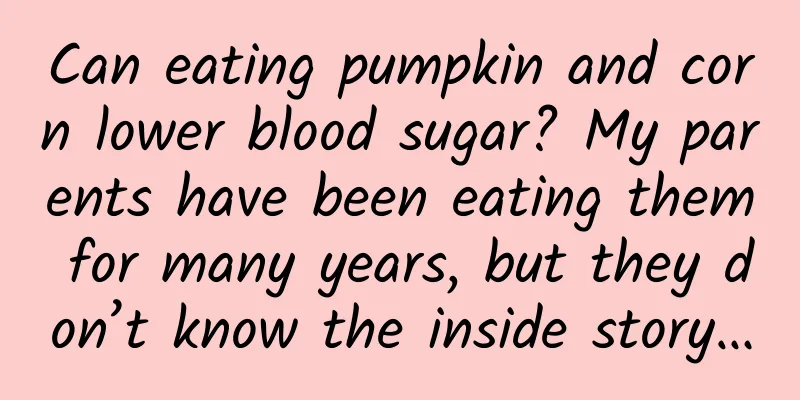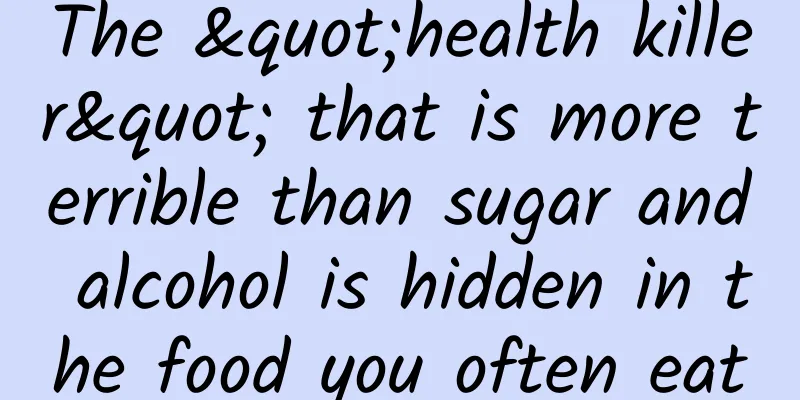Can eating pumpkin and corn lower blood sugar? My parents have been eating them for many years, but they don’t know the inside story…

|
Expert of this article: Dou Pan, deputy director of the Clinical Nutrition Department, Peking University First Hospital, nutritionist Many diabetic patients do not want to see high blood sugar levels. After eating something, I become anxious and worried. How can I lower my blood sugar? It is precisely because of everyone’s demand for lowering blood sugar that a wide variety of blood sugar-lowering foods have appeared on the market. The most widely circulated belief is that some diabetic patients regard pumpkin and corn as blood sugar-lowering drugs. So can eating pumpkin and corn really lower blood sugar? How to lower blood sugar scientifically? Let's take a look today. Can eating pumpkin and corn really lower blood sugar? In fact, any food, as long as it contains calories, will increase blood sugar after consumption. This fluctuation may vary in size and speed, but it is impossible for blood sugar to fall instead of rise. The reason why pumpkin and corn can lower blood sugar is that corn and pumpkin do contain ingredients that can improve blood sugar levels, but the key point is that the efficacy of a certain ingredient in food is not equal to the efficacy of the food itself! First, let’s look at the pumpkin. The "pumpkin polysaccharides" contained in pumpkin have a certain regulatory effect on blood lipids, blood sugar, and blood pressure in animal experiments; in addition, pumpkin also contains a soluble dietary fiber called "pectin", which can slow down the absorption of carbohydrates and delay the increase in blood sugar after meals. But despite the many benefits of "pumpkin polysaccharides" and "soluble dietary fiber" in pumpkin, every 100g of pumpkin itself contains 4.5g of carbohydrates and 22 kcal of calories. Generally speaking, the calories produced by every 350g-400g of pumpkin are approximately equal to those produced by half a steamed bun (25g of staple food). These calories will eventually be converted into glucose in the human body and absorbed by the body as blood sugar. Furthermore, the glycemic index of pumpkin is 75, which is 39 higher than apples, 32 higher than grapes, 25 higher than bananas, 9 higher than pineapples, and 5 higher than watermelons. It is a high glycemic index food. Therefore, if diabetics eat a lot of pumpkin, especially if they do not reduce their staple food intake, their blood sugar will not only not decrease, but will increase. Pumpkin is still edible. When choosing pumpkin, diabetic patients should choose tender pumpkin with high water content, low sugar content, sweet taste and high vitamin C, rather than old pumpkin rich in sugar and starch. Now let's look at corn. Corn is rich in polysaccharides, unsaturated fatty acids and vitamin E. The linoleic acid content is as high as 60%. Corn contains more magnesium and glutathione. In animal experiments, these ingredients can effectively lower the cholesterol concentration in the blood and improve insulin resistance. But corn also contains a lot of carbohydrates and is also a high glycemic index food. Every 100g of corn contains 106 kcal and 19.9g of carbohydrates. In other words, the calories in one medium-sized corn cob are approximately equal to those in half a fist-sized steamed bun (corresponding to 25g of staple food). Therefore, it is not advisable to eat corn to lower blood sugar. In summary, the effect of a high-concentration extract in food is not the same as the effect of food! Relying on food to lower blood sugar is not reliable. What other foods cannot lower blood sugar? Buckwheat: Buckwheat is rich in active ingredients such as bioflavonoids, sugar alcohols, D-chiro-inositol, anthocyanins, etc., and has significant effects in anti-tumor, anti-oxidation, scavenging free radicals, preventing and treating cardiovascular and cerebrovascular diseases, improving pancreatic islet function, and regulating blood sugar, blood lipids, and blood pressure. However, it is unreliable to achieve the effect of lowering blood sugar by eating buckwheat. It is recommended to include buckwheat in the total amount of staple food for a day, about 50g-100g per day. Buckwheat: Some studies suggest that the rutin in buckwheat can regulate the activity of insulin and help lower blood sugar, but the rutin content in buckwheat is very low, and the dose consumed in daily diet cannot lower blood sugar. Bitter melon: Bitter melon saponins extracted from bitter melon have an effect similar to insulin in animal experiments and can help lower blood sugar. However, the extraction process of bitter melon is extremely complicated. If you eat bitter melon directly, it will not lower blood sugar. It is recommended to include bitter melon in the total amount of vegetables per day, about 50g-200g per day. Okra: Okra contains a certain amount of soluble dietary fiber and is a good vegetable choice for diabetics. However, it is unrealistic to achieve the effect of lowering blood sugar by eating okra. Tremella: Tremella polysaccharides in Tremella can significantly lower the blood sugar level of alloxan diabetic mice, and can also significantly lower the blood sugar content of hyperglycemic animals and normal animals, and increase serum insulin levels. However, there is currently no evidence that daily consumption of Tremella fuciformis can lower blood sugar. It should be noted that although the above-mentioned foods cannot lower blood sugar when consumed directly, considering that they are rich in diverse nutrients, they should still be eaten to achieve a balanced diet. How to lower blood sugar scientifically? First of all, the food intake throughout the day must not only meet the needs of energy consumption, but also pay attention to nutritional balance, such as protein, vitamins, minerals, dietary fiber, etc. The recommended calorie distribution for diabetic patients for three meals a day is: 1/5 for breakfast, 2/5 for lunch, and 2/5 for dinner. Each meal should contain carbohydrates, fats and proteins in a fixed proportion. Food intake should be coordinated with medication and exercise, and should be taken at regular times and in regular quantities. For elderly people with diabetes who are also emaciated, special attention should be paid to increasing the intake of high-quality protein such as meat, eggs, milk, beans, etc., and at the same time strengthening physical exercise to avoid malnutrition and sarcopenia caused by overly strict dietary control. In summary Lowering blood sugar by eating pumpkin and corn Not advisable Scientifically master the method of lowering blood sugar Food intake Should be combined with medication and exercise The pictures in this article with the "Science Popularization China" watermark are all from the copyright gallery. The pictures are not authorized for reprinting. |
<<: The more beautiful the parts that girls care about the most, the more dangerous they are!
>>: Comic: Human Code Evolution Illustrated Book
Recommend
This is how advertisements will look good, here are the secrets to placing advertisements in the dating industry!
The threshold for entering the current marriage a...
What happened when a welder used melon seed shells to paint and sold them at a high price?
What happened when a welder used melon seed shell...
How to calculate the delayed retirement age? Could we catch up with the delayed retirement in 1974?
The "14th Five-Year Plan for the Development...
Traveling during the Spring Festival: A guide to protecting your health during the silver age
The auspicious dragon leaves the old year, the sn...
Archaeopteryx is not the "earliest bird" anymore? New discovery by Chinese scientists pushes back the history of bird evolution by 20 million years!
A Chinese research team recently discovered a 150...
Analysis of user operation strategies in internet celebrity live broadcast rooms!
How to get the audience to support you? To put it...
How to carry out refined operations of financial products?
Now that the cost of acquiring customers is getti...
Douyin e-commerce 618 marketing strategy
In another week, the annual Douyin 618 Good Produ...
Be careful! Eating raw eggs can be fatal! Be careful when choosing →
In recent years, raw eggs have become one of the ...
WeChat public accounts have added a comment function, and operators can choose to display selected comments in articles
According to the official notification of WeChat ...
6 design highlights to make fission activities successful!
Recently, a friend who works in operations compla...
Yoga Goddess Training Camp Slimming Yoga Class
Yoga Goddess Training Camp Slimming Yoga Class Re...
Why would anyone like to eat Houttuynia cordata?
When talking about Houttuynia cordata, the first ...
How will 360 search advertising promotion information be displayed and what are the conditions for displaying it?
How will my promotional information be displayed?...









